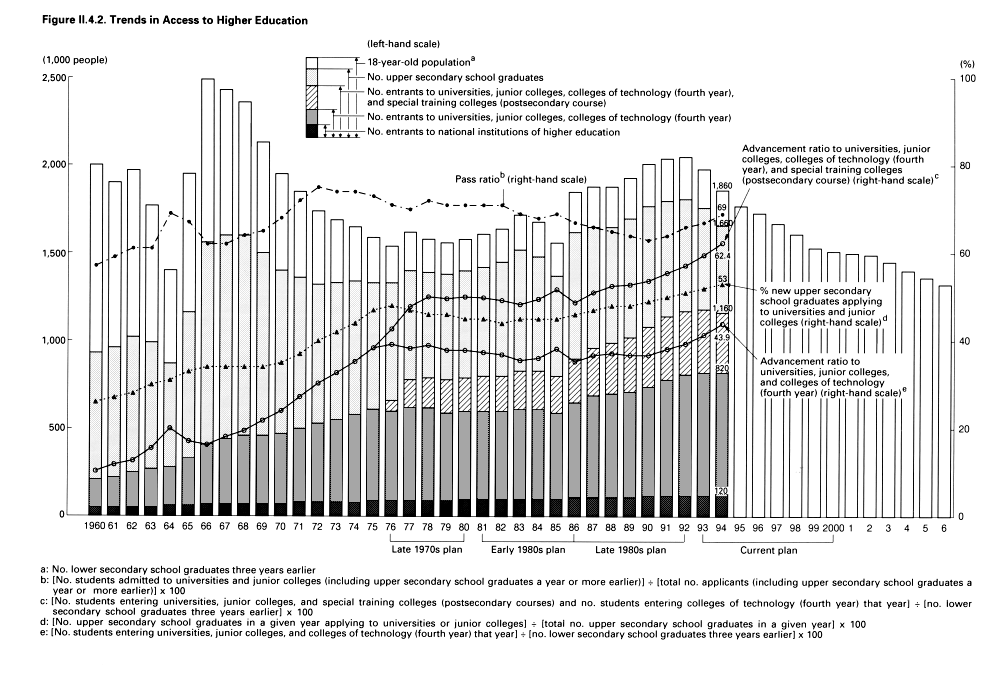| Home > Policy > White Paper, Notice, Announcement > White Paper > JAPANESE GOVERMENT POLICICIES IN EDUCATION, SCIENCE AND CULTURE 1994 > PART II Chapter 4 Section 3 2 | ||
In recent years the problems of national universities, including their aging and cramped facilities, have been the subject of debate in the National Diet and the focus of frequent media coverage. Education and research conducted in national universities are the foundation of Japan's present prosperity, and the improvement of the environment of those activities, including facilities and equipment, is an urgent and vital priority. In fiscal 1994 the Ministry of Education, Science and Culture made budgetary provision for the following measures, with particular emphasis on the development and enhancement of facilities and equipment.
* The teaching assistant system was established to improve conditions for graduate students by enabling the best students to work as teaching assistants, taking educational considerations into account, and thereby enhancing university education and providing opportunities for educational training. Funding for the system has been included in the budget since fiscal 1992.

Increased expenditures on educational facilities, including the revision of basic facility area units (an increase of approximately 20%), and the continued provision of funding for special facility improvement projects (20 billion yen), using the special facility improvement funding mechanism introduced in fiscal 1992, in order to alleviate the problem of aging and cramped buildings Separate provision of approximately 463.5 billion yen for facility expenditures (including equipment expenditures) in the supplementary budget for fiscal 1993
At the undergraduate level, general education faculties will be restructured to provide a basis for the university-wide provision of education that takes into account the relationship between general education and specialized education. In October 1994 the Faculty of International Studies was established at Utsunomiya University and the Faculty of Environmental Science and Technology was set up at Okayama University. The Graduate School of International Public Policy will be established at Osaka University, and the Graduate School of Social and Cultural Studies and the Graduate School of Mathematics will be established at Kyushu University.
In addition, existing faculties and graduate departments at Chiba University and Niigata University will be restructured and enhanced. Improvements will also be made at Muroran Institute of Technology, Ochanomizu University, and Kobe University of Mercantile Marine as part of general-education reform.
New undergraduate departments will be added to improve education and research in fields that are the focus of strong social demand, such as nursing. In addition, 104 departments at 16 universities will be restructured to keep pace with new advances and changing needs. Special emphasis will be placed on science and engineering. In the area of teacher training, there will be an ongoing shift to curricula based on the assumption that some students will enter professions other than teaching. Meanwhile, the quota for third-year transfer admissions will be raised by 130, chiefly because of the need to provide for lifelong learning.
The junior colleges of Niigata University (College of Commerce) and Shizuoka University (Junior College of Engineering) were constructively converted, mainly to provide evening courses, in October 1994. This measure reflects changes in the social environment in recent years, including increasingly sophisticated educational demand. Kobe University's School of Allied Medical Sciences was converted to a health science department within the medical faculty in October 1994. The aim of this change was to enhance university-level education in medical skills, such as nursing, and to train instructors.
The development of university hospitals will include prioritized increases in the numbers of nurses and other personnel. Treatment organizations will also be enhanced in areas that are the focus of strong social demand, such as intensive care.
Today Japan is under strong pressure to contribute to the international community through the promotion of scientific research and to train the talented researchers needed to sustain this contribution. In addition, rapid technological innovation, social and economic progress, and other factors have created a great demand for the training of people with advanced specialized knowledge and skills and for adult reeducation. Graduate schools will play an increasingly important role in meeting these needs, and the development and improvement of graduate schools has thus become a key policy priority.
In fiscal 1991 the Ministry of Education, Science and Culture implemented a number of reforms designed to provide greater flexibility in graduate school systems. The Ministry has also expanded budgetary allocations for graduate schools and is working to raise the levels of graduate education and research.
Measures relating to graduate schools in national universities include the establishment of graduate schools that are independent of undergraduate faculties. In addition, admission systems for students from abroad will be improved, and efforts will be made to promote organized cooperation with nonuniversity research institutes and other organizations actively involved in research. These measures will enable graduate schools to undertake pioneering interdisciplinary education and research that reflect trends in scientific research and social needs.
In fiscal 1994 the Ministry of Education, Science and Culture established 13 new graduate departments at 12 universities. The fields covered included information science and engineering, human and natural environment sciences, international development studies, international public policy, education, international development and cooperation, social and cultural studies, and mathematics. In addition, 32 new majors were introduced at 21 universities, in such fields as ocean and atmospheric science, international health, and regional administration. Steps were also taken to enhance systems for cooperation between graduate schools of the University of Tsukuba, Kyoto University, and Osaka University and private-sector research institutes, particularly in regard to education and research in science and engineering.
| Back to Top | MEXT HOME |